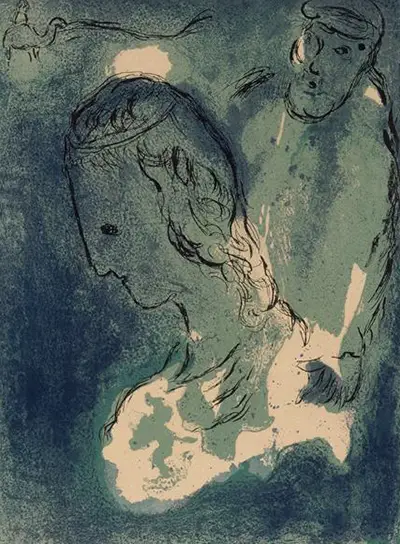This series of artworks is considered by some in the art world as one of the greatest artistic achievements in the modern world let alone Chagall's. The lithographs which were the 2nd installment of sorts to the series, all bear striking resemblances in form and style. These differ from the first installment which included the etchings and drawings that were done before the onset of the second world war.
Abraham and Sarah bear a striking resemblance to other pieces in the lithographs such as Sarah and the Angels or even Rehab and the Spies of Jericho. The piece contains three characters, with Sarah, the biggest among them. A third character is essentially a man on a four-legged creature that looks like a horse in a mountainous background. The two characters, in particular, Sarah and Abraham appear almost in a close-up manner which appears to be the norm in the entire series. The events also seem to be entirely detached from time and space another recurring character in the series.
Chagall's work has been described as easy, naïve, and childlike in its appearance and this is exemplified in Abraham and Sarah. From the relatively simple shapes that the two characters are created from to the three scheme color palette that makes the whole painting, this piece exemplifies Chagall's genius. He refers to his understanding and interpretation of the passage to create the lithograph. He gives us backstage access to his story Abraham and Sarah, portraying Sarah as Melancholic almost and Abraham just behind her surprised.
His expert use of color to bring texture is outstanding. He uses different shades to show distance, and in some areas, an absence of color defines Sarah's form. Chagall is said to have studied the biblical art of Rembrandt van Rijn and El Greco which gave him inspiration for this particular series. Most of the information around the painting is as interesting as the elements of this exemplary art. The Idea to undertake this project was floated by Ambroise Vollard, a famous art dealer, and publisher responsible for the blossoming of artists like Picasso and Pierre-Auguste Renoir.
After a previous successful collaboration, Vollard advised Chagall to create artwork based on the Old Testament of the Bible. Chagall, who was already fascinated by the bible and religion from his youth took to it like a fish to water. He traveled to Palestine in 1931 to prepare for the task, changing the course of his life forever both spiritually and creatively. Chagall has gone ahead to influenced and inspired other artists who have based their work on his and some who have gone ahead and developed his ideas further. Either way, he left a huge impact in the art world.
